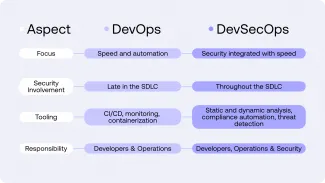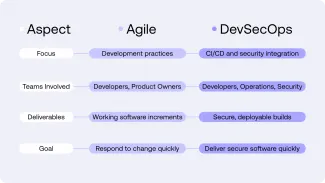What is DevSecOps?
DevSecOps Definition
DevSecOps is a natural evolution of DevOps, embedding security as a shared responsibility throughout the entire software development lifecycle (SDLC). The term itself is a portmanteau of Development, Security, and Operations. Rather than treating security as a separate phase that follows development, DevSecOps ensures that security is built into the product from the ground up, enabling teams to detect and fix vulnerabilities early, automate security checks, and maintain compliance with minimal friction.
At its core, DevSecOps is a cultural and technical shift that promotes security as a continuous and collaborative practice, not an afterthought. It empowers developers, security teams, and operations to work in tandem, fostering a mindset where "security is everyone’s responsibility."
DevSecOps vs DevOps: Key Differences Explained
While DevOps focuses on improving collaboration between development and operations teams to shorten the development lifecycle and increase deployment frequency, it historically overlooked security. Security was typically relegated to the end of the cycle, where manual reviews and assessments were conducted. This not only delayed releases but also left applications vulnerable to exploitation.
DevSecOps, in contrast, introduces a "shift-left" approach to security. This means integrating security considerations as early as possible in the development process, including threat modeling, secure coding practices, and automated testing for vulnerabilities. Security tools and policies are incorporated into CI/CD pipelines, ensuring real-time feedback and faster remediation.
Key Differences

Benefits and Advantages of DevSecOps
Adopting DevSecOps provides organizations with a significant competitive edge. Here are some of the primary benefits:
1. Early Detection and Mitigation of Vulnerabilities
By integrating security tools into development workflows, vulnerabilities can be detected during coding or testing rather than after deployment. This reduces both risk and remediation costs.
2. Increased Deployment Speed without Sacrificing Security
DevSecOps allows organizations to maintain rapid release cycles without compromising security, balancing agility with assurance.
3. Improved Collaboration and Shared Responsibility
DevSecOps promotes a culture of shared responsibility across departments, leading to better communication and unified objectives.
4. Compliance and Audit Readiness
Automated compliance checks and policy enforcement reduce the burden of manual audits and ensure continuous regulatory alignment.
5. Reduced Costs
Fixing security issues earlier in the lifecycle is far more cost-effective than dealing with breaches or post-production patches.
Key Concepts of DevSecOps
To successfully implement DevSecOps, it's crucial to understand the foundational concepts that guide this methodology:
1. Shift Left Security
The idea is to bring security into the early stages of the SDLC. This means performing code analysis, threat modeling, and vulnerability scanning as part of the development process.
2. Security as Code
Just as infrastructure can be managed with code (Infrastructure as Code), security policies and configurations can also be codified. This allows versioning, auditing, and consistent enforcement.
3. Immutable Infrastructure
Systems are deployed in consistent, repeatable states using tools like Terraform or Kubernetes. This ensures that security configurations remain intact across environments.
4. Automation
Automating security tests, compliance checks, and vulnerability scanning reduces human error and scales security across large, complex environments.
5. Continuous Monitoring
Post-deployment, systems are continuously monitored for anomalies, threats, and policy violations using tools like SIEM (Security Information and Event Management) and EDR (Endpoint Detection and Response).
6. Threat Modeling
This proactive step involves identifying potential threats and attack vectors before they become real vulnerabilities. It helps prioritize security efforts based on risk.
Top DevSecOps Tools for 2025
A successful DevSecOps strategy relies on the right tooling integrated into your CI/CD pipeline. Here are some commonly used tools across various stages:
Code Analysis
- SonarQube – For static code analysis
- Checkmarx – Scans for security vulnerabilities in code
Dependency Management
- OWASP Dependency-Check – Detects known vulnerable dependencies
- Snyk – Identifies and fixes vulnerabilities in open-source libraries
Container Security
- Aqua Security / Twistlock (now Prisma Cloud) – Scans container images
- Trivy – Simple and effective vulnerability scanner for containers
CI/CD Integration
- GIthub Actions, GitLab CI/CD, CircleCI – Support integrations with security scanners
Runtime Security
- Falco – Runtime security for containers
- Sysdig – Monitors system calls to detect abnormal behavior
Compliance and Monitoring
- Splunk, ELK Stack, Datadog – For logging and threat detection
- Open Policy Agent (OPA), Kyverno – For policy-based control across the stack
Best Practices for DevSecOps
Implementing DevSecOps isn’t just about tools. It requires a strategic, cultural transformation. Here are some of the best practices to follow:
1. Integrate Security from the Start
Make security a consideration during design and planning, not just during implementation.
2. Educate and Train Teams
Empower developers with secure coding training and awareness programs to foster ownership of security.
3. Automate Everything You Can
From code reviews to deployment, automation ensures consistency and scalability.
4. Use Metrics and KPIs
Track metrics like mean time to detect (MTTD), mean time to remediate (MTTR), and the number of vulnerabilities detected per build.
5. Foster Cross-functional Collaboration
Encourage joint ownership and communication between development, operations, and security teams.
6. Continuous Feedback Loops
Ensure feedback from security tools is visible and actionable to developers in real-time.
7. Conduct Regular Audits and Reviews
Automate compliance but also review findings regularly with human oversight.
The successful implementation of DevSecOps can be transformative. It enables faster, safer deployments, better collaboration, and a resilient security posture in today’s volatile cyber threat landscape. As a seasoned technologist who has helped enterprises align their DevSecOps goals with tangible business outcomes, I invite you to reach out. Whether you’re looking to evaluate your current DevSecOps maturity or explore toolchains tailored to your needs, let’s have a conversation.
Understanding the Differences Between Agile and DevSecOps
While Agile and DevSecOps both aim to increase the velocity and quality of software delivery, they operate at different layers of the SDLC and have distinct focuses:
Agile: The Methodology
Agile is a project management and development methodology that emphasizes iterative development, customer collaboration, and adaptive planning. Agile focuses on delivering small, incremental changes through sprints.
DevSecOps: The Operational Model
DevSecOps is more concerned with the infrastructure and tooling that support Agile processes, particularly how code is built, tested, deployed, and monitored with security in mind.
Key Differences

DevSecOps complements Agile by ensuring that each iteration is not only functional but also secure and production-ready.
Why DevSecOps is Essential in Modern Development
DevSecOps represents a crucial step forward in modern software engineering. In an age where threats evolve as rapidly as software itself, embedding security into the DNA of your development and operations processes is not optional—it’s essential. By adopting DevSecOps, organizations can eliminate the traditional silos between development, operations, and security, fostering a culture of shared responsibility and continuous improvement.
For CTOs, CIOs, and engineering leaders, embracing DevSecOps is not just a tactical move—it’s a strategic imperative that aligns technology with risk management and business agility.
If you’re ready to move beyond theory and apply these ideas in your organization, let’s connect. Whether you’re starting from scratch or looking to optimize your existing DevSecOps practices, the next step forward starts with a conversation.





















